Media, the negative body image scape goat for those with low self esteem
[Disclaimer: ...Any generic male pronouns are for both sexes. Writing he/she gets old and even though I'm female, I prefer to use male pronouns when referring to everyone. It's an English lit and paper writing habit. ]
Some people are focusing on the wrong things and wasting their time being angry and upset over it instead of changing themselves for the better for themselves. Not to mention that they usually don't have their information/facts/history straight either.
Thin or rather "not being fat/overweight" is not a product of the media now a day. It has existed throughout time:
Slim waist holds sway in history
Slim waists have been the mark of attractive women throughout history, says a US scholar who has analyzed thousands of ancient texts.
And the media does not make the small percentage of girls (and an even smaller percentage of guys) anorexic. It's a deep psychological problem. Stop blaming shit on media! When idols get too thin, the media gives them shit about it. Nichole Richie was called a coke whore, anorexic, drug addict, etc. When idols get too thin, they get publicly ridiculed and criticized for it.
If a person has a psyhcological problem concenring body image perception and slef worth, it was not created by the media or made by watching too many episodes of Popeye with skinny Olive Oyl in it. Quit blaming such distant outside forces. If peers have taken part in the problem, they are much, much closer to home than what's on TV or in magazines.
I'm not a size activist. I don't support the idea that people can be healthy at any/every size, because it's not true. Being overweight (or over-fat) creates health problems just as being underweight (under-fat) can. It may be different health complications, but they are still problems that aren't as prevalent when a person remains a healthy weight. Some body fat is necessary, but too much can be harmful. Just because someone is thin it doesn't mean that he/she is healthy, however having too much body fat definitely isn't a sign that the person may be healthy either.
So size advocacy is BS, because being a certain size has little to do with who a person really is or self worth. Body image is just part of a person's self worth and if he doesn't like how he is, he can always do something about it (like becoming active and cutting out junk food or whatever). Fat advocacy, fat pride, or fat acceptance is shallow. Being fat isn't healthy and being proud of being fat is shallow, because the pride is based on body image, not on health benefits of being fat (because there really aren't any). So BBM, BBW, SSBBW, and etc is shallow and ridiculous to me. No matter the size, everyone needs to eat healthy and exercise for body health.
"Real Women have real bodies with real curves." -DoveCampaignForRealBeauty.com
So Dove has been doing this so-called campaign for real beauty, which is supposed to help women get a healthier idea of what feminine beauty can be and divert focus away from the desire to be excessively thin. Okay, I got that. But isn't stating something like, real women have real curves kind of discriminatory and slightly prejudicial? Really, even thin women have curves, and sometimes those who are a little heavier don't really have much curves or an hourglass shape...
And really real women have curves is bull. Less than 9% of American women have hourglass figures (bust and waist the same in circumference with the waist being at least 25% smaller than either) now a day with over 40% being rectangles (bust and hips about the same with a waits that is over 75% the circumference of the bust or hips). And being overweight doesn't give a person curves either. Often women lose the curves that they have when they add fat weight (assuming that they aren't underweight to start with). Instead of spouting insecure and delusional BS like, Real women having real bodies with real curves," how about something like, "Real women don't have to put other women down because of personal insecurities and biases with their body image perception"?
Body image is not the end all be all of self worth, but please don't try to justify being out of shape or complain that society doesn't view out of shape bodies attractive. Instead of trying to blame outside sources on your problems, do something about yourself and make a move toward being healthier. Eating better and becoming active gives you energy, strength, endurance, improved health... It can make you happier (exercising releases happy endorphins) and give you a self esteem boost that is justifiable.
By the way, have you seen the Dove billboard ads for Real Beauty?
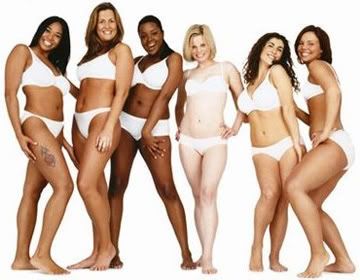
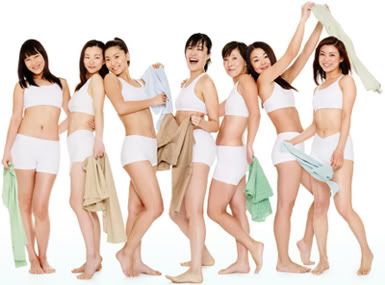
One if the advertisement for the US and the other for Japan. Interesting, right?
Instead of the motto being real women have real curves it's something like I won't hide my skin anymore. In Japan, the majority of women are Japanese (what a surprise right) and most don't tan, so if you look at average girls, that is what you'll get. The girls in the picture are Japanese, Chinese and Korean, ages ranging from mid twenties through mid-forties. They are about the average size and build, not very muscular, not too thin, just average. Unlike the US motto that (whether intentionally or not) demonizes those who're different, slimmer, more fit, the Japanese one focuses one focuses on a more positive and personal message. Which is much better because I think that when people can truly learn how to except/love themselves, they'll actually make lide changes to take care of themselves.
But what about those cool Dove commercials about how evil the media is?
...Uh, excuse me, but idealizing the human body isn't anything new. What is generally presented as the desired body image (usually pertaining to body size/shape/weight) just seems out of reach to more people now then perhaps a couple decades ago. Why? More people are overweight now a day, versus back when my mother was a kid. More people eat more junk food more often.
There is the whining about how thin is in... You'd almost think that if being very thin was such a desired thing, the percentage of overweight people in the United States would be much, much lower than over 60%. And women who're considered to be thin, or waifs don't necessarily feel attractive just because they're thin. Obviously people don't necessarily find a person to be attractive just because he/she is thin either. For example, a couple years back when I was watching a runway show on TV, my boyfriend and his friends complained about how unattractive the girls were. They had never seen a runway show before and just assumed that all models are good looking. ...Until they saw part of that show of course.
Sure runway models are thin... It's easier to make conceptual clothes for a straighter-figured women. Obviously a lot less tapering is involved. And despite what that TV reality show portrays, runway models don't have to be very attractive... Just the right shape and height. The models aren't meant to be the ideal body shape/size for all women. They're just wearing the clothing. It's all about showcasing the clothes, not the people wearing them.
Back to me stating that idealized body images have existed for a long time... Idealized body images have existed for a long time. Whether fat, thin, muscular, emphasizing particular body parts... None of this is new.
So, I figured that I might want to try to post some stuff on this ideal body image business. Depending upon the region/culture a skinny, flabby, fat, curvy, or muscular body is the ideal form. All can be examples of status/wealth symbols... And any culture that views any certain physical forms as ideal will always have women and men who're pressured into fitting the model, no matter what reasons are behind the so-called ideal form.
As the time changes, cultures change and physical forms that used to be considered as beautiful may change (though thin or healthy weight seemed to be popular throughout time). Sometimes the ideal body image changes within a culture over just a few decades, almost like a fad falling in and out of style. So let's look at some examples through some different forms of art: Click on the thumbnails below to view a larger and more compete versions of the images.
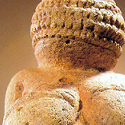
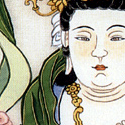
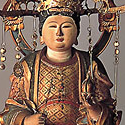
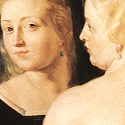
Looking at this and other prehistoric idols like The Venus of Willendorf, you can tell that it's a fertility statue. She has no face, which might indicate that she was no one specifically and that her body was the focus. Her genital area, stomach and breasts have been deliberately emphasized through enlarging them to a bizarre degree. But the figure doesn't have a protruding butt. Being that she is probably a fertility figure, detail, the enlargement, or even the existence of certain parts aren't necessary. Such parts include the face, buttocks, arms, and feet. The figurine was never given feet, which may imply that it wasn't even supposed to be a something that could stand or move on its own.
The Venus of Willendorf statue and other idols that are made supernaturally obese (seemingly fat in only certain areas and normal if not thin in others) is a cultural invention. Other examples can be found in Chinese art where a chatacter have fat-folds on the neck, but nowhere else on the body. During certain times, within certain societies, obesity or excess body fat was considered to be a symbol of wealth and higher status, but not necessarily health or beauty. Where there was a large class gap, the lower class didn't have much to eat and had to work physically demanding jobs all day, being able to be obese was a status symbol. It implied that a person was so rich, he could eat enough to pack on/keep the adipose fat and didn't have to do low-level work like physical labor. In places where famine occurred or there was a food shortage, the obese would have better chances to survive or be able to give birth to children. But in societies where food became more accessible to more people, those kinds of body images would fall out of style.

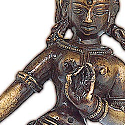

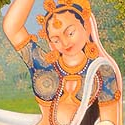

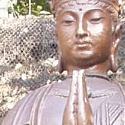
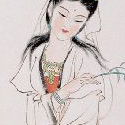

In India, the female form of supernatural characters (like Siddhartha's mother and goddesses) were drawn as very curvy and voluptuous, scantily clad figures. Most of these are replicas of images of Siddhartha's mother, Queen Maya. Any image of her hanging on a tree with one arm is drawn from the supernatural birth of her son. The female forms aren't muscular looking but they certainly aren't obese and they aren't typically too skinny (though it is present some of the time).
When Buddhism was brought in from India, Chinese's religious art took on some of the Indian characteristics, but the female form was toned down. Looking at Buddhist artwork, you can see that there is a period where being over-weight was considered to be something desirable. Much of the art was done by lower class people who saw the upper-class/rich as almost supernatural beings. Which is why many Chinese gods look much like magistrates and politicians. Even though the figures have enough excess fat to create fat folds around the neck, they are not obese or anywhere near as large as Miluo fo (the fat Chinese Buddha).
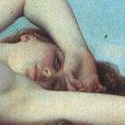
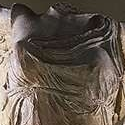
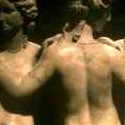
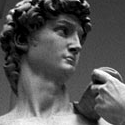
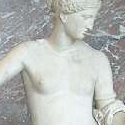
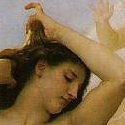


Though they all might not look it, each one is an idealized image of the human body. The idea that a person can complain about how the media is projecting an unreal ideal body image, while all of this wonderful art exists that was doing the very same thing is so surreal. How can some people be so insanely hypocritical? Well, I suppose the answer is obvious. They haven't taken into consideration art of human forms... They haven't really thought to themselves why figures in Reuben's work or images of the Buddha were done a certain way. No. Instead, I think that often people who complain about the media putting peer pressure on people (and by people they're talking about themselves) or how unfair and unrealistic some of the women look in magazines are complaining because they have a desire to look like those figures, but recognize a disparity between their own form and the ones that they want.
Well, you know what... Instead of wasting time complaining, self-loathing, and hating others or body images for looking (what they at least perceive as) better than their own, they should try to work towards gaining more confidence about their forms. How? Obviously an irrational sense of self-worth (concerning body image) is just some self-denial. Rather, people should try to stay healthy and active. Working out, becoming more active, and cleaning up one's diet some (if needed) can give a person a great boost in confidence.
It's legitimate confidence, not some delusional idea that they're fine the way they are. Nothing wrong with loving our bodies, even if we admit that we could be in better shape. An excessive love for it, to the point where we believe that we're perfect just as we are just ridiculous though. But if we really love our bodies, we will take care of them. After all they are the only homes we got.
If you want to debate about anything, read the whole thing first and go for it. I know it's kind of a long post, but I just wanted to get it all out there. It may save time for you guys in the future... If you have any questions, feel free to ask.
Some people are focusing on the wrong things and wasting their time being angry and upset over it instead of changing themselves for the better for themselves. Not to mention that they usually don't have their information/facts/history straight either.
Thin or rather "not being fat/overweight" is not a product of the media now a day. It has existed throughout time:
Slim waist holds sway in history
Slim waists have been the mark of attractive women throughout history, says a US scholar who has analyzed thousands of ancient texts.
And the media does not make the small percentage of girls (and an even smaller percentage of guys) anorexic. It's a deep psychological problem. Stop blaming shit on media! When idols get too thin, the media gives them shit about it. Nichole Richie was called a coke whore, anorexic, drug addict, etc. When idols get too thin, they get publicly ridiculed and criticized for it.
If a person has a psyhcological problem concenring body image perception and slef worth, it was not created by the media or made by watching too many episodes of Popeye with skinny Olive Oyl in it. Quit blaming such distant outside forces. If peers have taken part in the problem, they are much, much closer to home than what's on TV or in magazines.
I'm not a size activist. I don't support the idea that people can be healthy at any/every size, because it's not true. Being overweight (or over-fat) creates health problems just as being underweight (under-fat) can. It may be different health complications, but they are still problems that aren't as prevalent when a person remains a healthy weight. Some body fat is necessary, but too much can be harmful. Just because someone is thin it doesn't mean that he/she is healthy, however having too much body fat definitely isn't a sign that the person may be healthy either.
So size advocacy is BS, because being a certain size has little to do with who a person really is or self worth. Body image is just part of a person's self worth and if he doesn't like how he is, he can always do something about it (like becoming active and cutting out junk food or whatever). Fat advocacy, fat pride, or fat acceptance is shallow. Being fat isn't healthy and being proud of being fat is shallow, because the pride is based on body image, not on health benefits of being fat (because there really aren't any). So BBM, BBW, SSBBW, and etc is shallow and ridiculous to me. No matter the size, everyone needs to eat healthy and exercise for body health.
"Real Women have real bodies with real curves." -DoveCampaignForRealBeauty.com
So Dove has been doing this so-called campaign for real beauty, which is supposed to help women get a healthier idea of what feminine beauty can be and divert focus away from the desire to be excessively thin. Okay, I got that. But isn't stating something like, real women have real curves kind of discriminatory and slightly prejudicial? Really, even thin women have curves, and sometimes those who are a little heavier don't really have much curves or an hourglass shape...
And really real women have curves is bull. Less than 9% of American women have hourglass figures (bust and waist the same in circumference with the waist being at least 25% smaller than either) now a day with over 40% being rectangles (bust and hips about the same with a waits that is over 75% the circumference of the bust or hips). And being overweight doesn't give a person curves either. Often women lose the curves that they have when they add fat weight (assuming that they aren't underweight to start with). Instead of spouting insecure and delusional BS like, Real women having real bodies with real curves," how about something like, "Real women don't have to put other women down because of personal insecurities and biases with their body image perception"?
Body image is not the end all be all of self worth, but please don't try to justify being out of shape or complain that society doesn't view out of shape bodies attractive. Instead of trying to blame outside sources on your problems, do something about yourself and make a move toward being healthier. Eating better and becoming active gives you energy, strength, endurance, improved health... It can make you happier (exercising releases happy endorphins) and give you a self esteem boost that is justifiable.
By the way, have you seen the Dove billboard ads for Real Beauty?


One if the advertisement for the US and the other for Japan. Interesting, right?
Instead of the motto being real women have real curves it's something like I won't hide my skin anymore. In Japan, the majority of women are Japanese (what a surprise right) and most don't tan, so if you look at average girls, that is what you'll get. The girls in the picture are Japanese, Chinese and Korean, ages ranging from mid twenties through mid-forties. They are about the average size and build, not very muscular, not too thin, just average. Unlike the US motto that (whether intentionally or not) demonizes those who're different, slimmer, more fit, the Japanese one focuses one focuses on a more positive and personal message. Which is much better because I think that when people can truly learn how to except/love themselves, they'll actually make lide changes to take care of themselves.
But what about those cool Dove commercials about how evil the media is?
...Uh, excuse me, but idealizing the human body isn't anything new. What is generally presented as the desired body image (usually pertaining to body size/shape/weight) just seems out of reach to more people now then perhaps a couple decades ago. Why? More people are overweight now a day, versus back when my mother was a kid. More people eat more junk food more often.
There is the whining about how thin is in... You'd almost think that if being very thin was such a desired thing, the percentage of overweight people in the United States would be much, much lower than over 60%. And women who're considered to be thin, or waifs don't necessarily feel attractive just because they're thin. Obviously people don't necessarily find a person to be attractive just because he/she is thin either. For example, a couple years back when I was watching a runway show on TV, my boyfriend and his friends complained about how unattractive the girls were. They had never seen a runway show before and just assumed that all models are good looking. ...Until they saw part of that show of course.
Sure runway models are thin... It's easier to make conceptual clothes for a straighter-figured women. Obviously a lot less tapering is involved. And despite what that TV reality show portrays, runway models don't have to be very attractive... Just the right shape and height. The models aren't meant to be the ideal body shape/size for all women. They're just wearing the clothing. It's all about showcasing the clothes, not the people wearing them.
Back to me stating that idealized body images have existed for a long time... Idealized body images have existed for a long time. Whether fat, thin, muscular, emphasizing particular body parts... None of this is new.
So, I figured that I might want to try to post some stuff on this ideal body image business. Depending upon the region/culture a skinny, flabby, fat, curvy, or muscular body is the ideal form. All can be examples of status/wealth symbols... And any culture that views any certain physical forms as ideal will always have women and men who're pressured into fitting the model, no matter what reasons are behind the so-called ideal form.
As the time changes, cultures change and physical forms that used to be considered as beautiful may change (though thin or healthy weight seemed to be popular throughout time). Sometimes the ideal body image changes within a culture over just a few decades, almost like a fad falling in and out of style. So let's look at some examples through some different forms of art: Click on the thumbnails below to view a larger and more compete versions of the images.




Looking at this and other prehistoric idols like The Venus of Willendorf, you can tell that it's a fertility statue. She has no face, which might indicate that she was no one specifically and that her body was the focus. Her genital area, stomach and breasts have been deliberately emphasized through enlarging them to a bizarre degree. But the figure doesn't have a protruding butt. Being that she is probably a fertility figure, detail, the enlargement, or even the existence of certain parts aren't necessary. Such parts include the face, buttocks, arms, and feet. The figurine was never given feet, which may imply that it wasn't even supposed to be a something that could stand or move on its own.
The Venus of Willendorf statue and other idols that are made supernaturally obese (seemingly fat in only certain areas and normal if not thin in others) is a cultural invention. Other examples can be found in Chinese art where a chatacter have fat-folds on the neck, but nowhere else on the body. During certain times, within certain societies, obesity or excess body fat was considered to be a symbol of wealth and higher status, but not necessarily health or beauty. Where there was a large class gap, the lower class didn't have much to eat and had to work physically demanding jobs all day, being able to be obese was a status symbol. It implied that a person was so rich, he could eat enough to pack on/keep the adipose fat and didn't have to do low-level work like physical labor. In places where famine occurred or there was a food shortage, the obese would have better chances to survive or be able to give birth to children. But in societies where food became more accessible to more people, those kinds of body images would fall out of style.








In India, the female form of supernatural characters (like Siddhartha's mother and goddesses) were drawn as very curvy and voluptuous, scantily clad figures. Most of these are replicas of images of Siddhartha's mother, Queen Maya. Any image of her hanging on a tree with one arm is drawn from the supernatural birth of her son. The female forms aren't muscular looking but they certainly aren't obese and they aren't typically too skinny (though it is present some of the time).
When Buddhism was brought in from India, Chinese's religious art took on some of the Indian characteristics, but the female form was toned down. Looking at Buddhist artwork, you can see that there is a period where being over-weight was considered to be something desirable. Much of the art was done by lower class people who saw the upper-class/rich as almost supernatural beings. Which is why many Chinese gods look much like magistrates and politicians. Even though the figures have enough excess fat to create fat folds around the neck, they are not obese or anywhere near as large as Miluo fo (the fat Chinese Buddha).








Though they all might not look it, each one is an idealized image of the human body. The idea that a person can complain about how the media is projecting an unreal ideal body image, while all of this wonderful art exists that was doing the very same thing is so surreal. How can some people be so insanely hypocritical? Well, I suppose the answer is obvious. They haven't taken into consideration art of human forms... They haven't really thought to themselves why figures in Reuben's work or images of the Buddha were done a certain way. No. Instead, I think that often people who complain about the media putting peer pressure on people (and by people they're talking about themselves) or how unfair and unrealistic some of the women look in magazines are complaining because they have a desire to look like those figures, but recognize a disparity between their own form and the ones that they want.
Well, you know what... Instead of wasting time complaining, self-loathing, and hating others or body images for looking (what they at least perceive as) better than their own, they should try to work towards gaining more confidence about their forms. How? Obviously an irrational sense of self-worth (concerning body image) is just some self-denial. Rather, people should try to stay healthy and active. Working out, becoming more active, and cleaning up one's diet some (if needed) can give a person a great boost in confidence.
It's legitimate confidence, not some delusional idea that they're fine the way they are. Nothing wrong with loving our bodies, even if we admit that we could be in better shape. An excessive love for it, to the point where we believe that we're perfect just as we are just ridiculous though. But if we really love our bodies, we will take care of them. After all they are the only homes we got.
If you want to debate about anything, read the whole thing first and go for it. I know it's kind of a long post, but I just wanted to get it all out there. It may save time for you guys in the future... If you have any questions, feel free to ask.